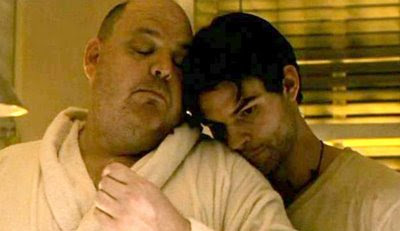Eat or Die: Cannibalism as Manifest Destiny in "Ravenous"
 Forgive me reader, for I have sinned. It has been two weeks since my last post and I wanted to let you know I haven’t forgotten about you. To make it up I have several new posts rolling out this week, the first of which is a examination of cannibalism in Ravenous. Enjoy.
Forgive me reader, for I have sinned. It has been two weeks since my last post and I wanted to let you know I haven’t forgotten about you. To make it up I have several new posts rolling out this week, the first of which is a examination of cannibalism in Ravenous. Enjoy.For those of us fascinated by horror, we can always trace back our obsession to a single film or moment in time when horror grabbed us and didn’t let go. For me one of those moments was when I watched Ravenous, a horrifying story of cannibalism set on the American frontier that draws a parallel between consuming flesh and the US desire to consume the continent that drove the theory of manifest destiny.
Manifest destiny arose in the 19th century as the belief that the United states was destined to occupy the continent of North America from the Atlantic to the Pacific oceans. This idea drove westward expansion in the 1800s as intrepid Americans pressed on to bring civilization and Christianity to the open frontier.
Ravenous opens up in the heart of the Mexican-American war, one of the major conflicts fueled by manifest destiny after the annexation of Texas. We follow Captain John Boyd being honored for his bravery in battle at a steak dinner. But Boyd is no hero. During a pivotal battle with Mexican fighters, he plays dead to avoid being killed. The fighters don’t realize he’s playing possum and he gets transported behind enemy lines. This is where Boyd first acquires his taste for blood. Stretched beneath the corpses of his bravely departed comrades, he can do nothing as the blood of his slain captain drips down his throat.
Despite Boyd’s capture of the Mexican base, his superiors send him to the remote Fort Spencer in California where he is third in command under the ailing Colonel Hart and his rag tag outfit which includes the drunken Knox, the hyper masculine Cleave, and Martha the Indian guide. It’s not long before a stranger, F.W. Colqhoun, stumbles upon the fort and tells them a harrowing story of cannibalism on the frontier.
According to Colqhoun, he was part of a party of travelers pressing west into California when the bitter winter took them by surprise. Low on supplies they ate the oxen, horses and eventually began gnawing on their shoe leather for sustenance. When one of the party dies, the others serve him up on a platter to keep themselves alive.So what’s the connection between cannibalism and manifest destiny? Looking at the character of Colqhoun, he is first presented as “other” because he has engaged in the taboo of eating human flesh. The others are horrified by his story, a horror that increases with the knowledge that Calqhoun alone has slain and eaten the entire traveling party. In this light, it’s easy to dismiss his character as a backwoods lunatic, a man who has lost his senses to hunger. It’s when he returns to Fort Spencer in the guise of Colonel Ives to replace Colonel Hart that our perception of him changes. By putting Colqhoun in a place of power as Colonel Ives, the film draws a parallel between the actions of the military and cannibalism. Just as Colqhoun devours human flesh so does Colonel Ives in carrying out the imperialist mission of the military, an idea that heightens our terror. The crazed cannibal and the cool captain are one in the same as the monstrosity of manifest destiny mirrors that of flesh eating.
Colqhoun makes this parallel evident when he tells Boyd of his grand plan after taking over the fort. “You know come April,” he tells Boyd, “thousands of gold-hungry Americans will come over those mountains, on their way to new lives, passing right through..here” Colqhoun makes it clear that he plans on eating some of those settlers to keep his new society, including the revived Colonel Hart alive. Just like the settlers who go west to devour the land in front of them, so will Colqhoun feast on their flesh.
The film’s critique of monstrous manifest destiny ends on a bleak note, as the Indian guide Martha walks in on Colqhoun and Boyd locked in a death embrace. In Martha, the film offers a simple enough solution to the all-consuming hunger of American imperialism: just walk away. The camera follows Martha as she departs into wilderness, but it seems that nothing is that simple. The camera shifts its eye and we watch as the officer Martha brought back to the fort on Ive’s orders takes a sip of the bubbling stew made from human flesh, suggesting that while you can walk away, the vicious cycle of hunger will continue.






Great cast in this flick!
ReplyDeleteYou posted some of my fave vamps - Martin and Miriam from The Hunger amongst them - well done!
ReplyDeleteNow get better!!!